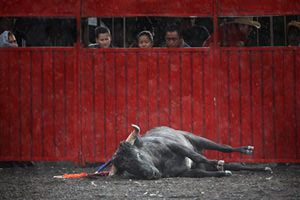Inching Away From Bullfighting and Its Macho B.S.
Catalonia has imposed a 2012 ban on the tradition, which is losing support throughout Spain. Could this toxic mix of blood lust and male preening finally be on its way out?In the face of Catalonia’s coming ban, could this toxic mix of blood lust and male preening be on its way out throughout Spain?
When the regional parliament of Catalonia voted last month to ban bullfighting, the howls of protest across Spain resounded louder than the collective death cries of the thousands of bulls killed in the nation’s rings each year. The economic loss will be intolerable! An important national tradition will be undermined! Catalonia acted out of spite against the rest of Spain, not to save the half-ton brutes that provide so much fun for so many!
It seems a lot of folks just cannot believe that any good Spaniard should have to go without regularly seeing a sword plunged into the racing heart of a blood-smeared bovine.
Among those outraged by the decision was the Catalonian poet Pere Gimferrer, who proclaimed it “the worst attack on culture since our transition to democracy.”
Matador Serafín Marín struggled unsuccessfully to hold back tears as he slammed what he termed a product of dictatorship. He went on to defend bullfighting by saying: “It is not a cruel show. It is a show that creates art. …”
There’s nothing unusual about people complaining against change in cultural institutions, even when those fixtures are worthy of condemnation; our familiar devils, however ugly they may be, occupy a comfortable corner of the psyche. In exorcizing a practice with deep roots in Spain, Catalonia is taking a historic step against a barbarism that is long past its day. Last month’s vote sends word to the rest of the country and to every other place where bulls are killed in the ring: That rapping, rapping at your chamber door is the 21st century wanting to come in. You are clinging to a savage throwback that sees merit in tormenting animals, that finds virtue in a toxic mix of blood lust and male preening.
The vote that upset so many Spaniards — especially conservatives — and bullfight aficionados elsewhere occurred July 28. Under the measure, passed 68 to 55, bullfights will be outlawed starting in January 2012 in Catalonia, where there now is only one functioning ring and where the activity does not have heavy popular support.
The ballot was taken after the legislature of the autonomous region received two petitions — one from the World Society for the Protection of Animals bearing 140,000 signatures gathered in 120 nations and one from an anti-bullfight group named Prou! (Catalan for enough) that carried the names of 180,000 Catalonians.
Among the prominent foreigners pushing for the ban was British comedian Ricky Gervais, who spoke out in the press and on the website of the world association that submitted signatures: “Sometimes the worst kind of cruelty is done in the name of entertainment. It sickens me to know that people still pay money to see an animal tortured to death. Cultural heritage is no excuse for inflicting such pain on a frightened and confused animal.”
The type of bullfighting being addressed by Gervais, and by this article, is the lethal Spanish variety, practiced mainly in Spain and some Latin American countries including Mexico. Across the world there are many styles of bullfighting, some of which spare the bull’s life, but none will win any bouquets from animal-rights backers. All bullfighting is abusive, and even in some of the “bloodless” events the bull can’t catch a break: Although it isn’t killed by the matador in the ring, it’s delivered to a butcher outside who carves it into steaks.
Whatever laws Catalonia might have concerning bullfighting, this region, one of 17 so-called autonomous communities throughout Spain, makes up just a small part of the country. A bit larger than Maryland, it constitutes only about 6 percent of the Spanish landmass. But Catalonia is heavily populated, with 7.5 million of Spain’s 46 million people, and, never a shy violet, sees itself as a nation within a nation, a cultural bellwether and a wealthy, sophisticated land with a fiery love of independence. Historically, its relationship with Spain’s national government has been tense, and passionate differences persist.
Late in June the Spanish constitutional court issued an important ruling limiting the region’s potential for autonomy, causing perhaps a million protesters to gather last month in Barcelona, the capital of Catalonia. Many non-Catalonians see July’s parliamentary action as a show of anger and nationalist ambition rather than a move to protect animals, and they accuse the region of being disingenuous in creating a false international display. They also point out that Catalonia has not prohibited bull runs, in which the animals, although not stabbed, are sometimes roped, taunted, harassed and otherwise abused. In the spectacle known as bou embolat — denounced by opponents of cruelty to animals — wax balls and on occasion fireworks are attached to the horns and then ignited. Click here for a video, but be forewarned that if you are sensitive to misuse of animals you might not like what you see. As a crowd applauds, flames and then fountains of sparks shoot from the tips of a bull’s horns as the agitated beast races about. What’s at the heart of the unrest of the pro-bullfight set in Spain is fear that a trend is running against the tradition and that the endgame is approaching. In 1991 the Canary Islands banned the fights — if fights is indeed the right word for encounters in which one side almost always wins — and now a mainland region has turned thumbs down on the “sport.” (The term sport as applied to bullfighting, or the corrida, is frowned on by both bullfight supporters who insist that the activity is instead actually an art form and foes who maintain the activity is far outside the ethics and values of true sports. Hemingway wrote, “The bullfight is not a sport in the Anglo-Saxon sense of the word. …”)
One Internet article that argued against the Catalonian ban was headlined with the ominous question “Bullfights — The Beginning of the End?” and the Financial Times said: “[The] vote confirms a rising wave of opposition that could lead to a more widespread prohibition of the spectacle known in Spain as ‘la fiesta nacional’. … Although most older Spaniards are either indifferent to, or fans of, the sport, surveys show that a growing number of the under-30s oppose it, and cruelty to animals in general.”
The clicking that apprehensive lovers of bullfighting are hearing in the distance is the sound of falling dominoes. The aficionados are on the wrong side of history, and in their heart of hearts they know it. Look at the list of once-beloved blood sports that are now widely condemned or outlawed and, in some cases, considered unthinkable. Some have long faded from societal memory, although others persist at greatly reduced levels. A partial inventory:
• Bear-and-bull fights. • Bull baiting — bulls against dogs. • Badger baiting — badgers against dogs. • Rat baiting — rats against dogs. • Cockfights — roosters against roosters. • Dog fighting — setting dogs such as pit bulls against one another. • Fox hunting — in which riders and hounds pursued a quarry that usually ended up being dismembered by the dogs.
For most Americans, bullfighting is an out-of-sight, out-of-mind, not-in-our-backyard, why-should-we-care happening. But our U.S. of A. has no shortage of its own abusive traditions to answer for. The American custom that is closest to bullfighting is the rodeo — reprehensible albeit far less deadly to the nonhuman participants than bullfighting.
Also accepted and thriving in the United States and elsewhere are recreational hunting and recreational fishing, which are similar in some ways to blood sports and generally are motivated by the pleasure of finding and killing wild prey rather than by the need to obtain food for human survival. The recreational categories of course do not include tribe members and others who hunt or fish primarily to survive.
Catch-and-release fishermen may see themselves as guardians of morality as well as conservation, but in examining their practice, it’s hard to find nobility in torturing the object of desire for just a while before magnanimously letting it swim away.
Acceptance of sport hunting and fishing is bolstered by endless Norman Rockwell-like photos of families in magnificent landscapes and sweet stories of familial bonding on the banks of forest streams. Unfortunately, what’s pulling Dad, Mom, Junior and Sis together is a bit of good old-fashioned killing.
(As I finished writing that paragraph, I had a vision of being chased by a bunch of fisher-people and hunters hankering to have me gutted, stuffed and mounted. Of course, they would have to queue up behind a posse wearing cowboy hats and swinging thick ropes suitable for a hanging.)
In fairness, it must be noted that hunters and anglers help some animal species by providing funds, through license fees, for governmental wildlife programs. Also, hunting and fishing can benefit some types of animals by thinning populations that otherwise might perish because they would overwhelm available food sources, or by reducing the number of predators that feed on them.
Although they do love their rodeos, their hunting and their fishing, Americans can’t be accused of being worshipers of the bullfight. A Spanish-style, kill-by-sword bullfight was held in Dodge City, Kan., as part of a Fourth of July celebration in 1884, but the corrida never caught on in a big way among the gringos. Killing in rings is now illegal in this country (bloodless fights are permitted in California and some other states under certain restrictions), and most Americans have never seen a bullfight in person. For those who don’t know exactly what they are missing, here are a few highlights (I use the word loosely) from a sanitized primer on a Web page named — really — “Bull Fight 101,” at a site operated by a band of California enthusiasts called Club Taurino de Chula Vista.
The first act concludes with the entrance of the “picadors”; the (usually chubby) guys on horseback. The picadors’ job is to weaken the bull’s very powerful neck muscle by enticing the bull to charge the heavily padded horses and then to pierce the neck muscle with a long lance. …
The second act concludes with the placing of the “banderillas” (the brilliantly colored short harpoons) into the bull’s neck and shoulders. This is done primarily for traditional reasons but practically to correct any tendencies for the bull to hook his horns to left or right. …
The third and final act … concludes when the matador trades his ceremonial sword for a real one and prepares to kill the bull. This is the most dangerous time for the matador since he must quickly lean in over the horns and find a very small target (about the size of the palm of your hand) to place the sword between the bull’s shoulder blades. If done well this event is over in seconds and the bull expires within a few minutes or less.
The website does not mention that the “heavily padded horses” have been used only since 1930. Before then, unpadded horses were ridden in the rings and they usually were disemboweled by the bulls, resulting in a greater death count among equines than among bovines. At the time the padding requirement was introduced, there were outcries that the reform would detract from the spectacle and lead to the demise of bullfighting, but there proved to be still enough blood flowing to hold spectators’ attention over the years.
Some of that blood has issued at times from the creature on blunt end of the estoque, the killing sword. Fewer than five dozen matadors have been killed in Spanish-style bullfighting over the last three centuries, but injuries to bullfighters are common. In May, Julio Aparicio, one of Spain’s most famous matadors, was the victim of a grotesque goring, depicted in widely distributed photographs. (Sorry, no hyperlink here; Google it if you are up for the sight of a horn tip protruding from the flesh of an impaled man.)
In 2007, a then 14-year-old bullfighter almost died in a ring; undeterred, he went on to slay six bulls on a single February day this year. In June, a 22-year-old Mexican matador, deciding he was no glutton for punishment after being gored the previous month, ran from a Mexico City ring. “I didn’t have the ability, I didn’t have the balls, this is not my thing,” he said after he escaped from the bull. His candor did not prevent him from being arrested and fined for breach of contract. The management did not take kindly to the yellow streak exhibited at its afternoon “art” show.
The corrida-equals-art formulation — a common theme in bullfighting literature — appears at the conclusion of the “Bull Fight 101” Web page, which explains that the “bull is to the matador as a violin is to a violinist or a block of stone is to a sculptor. He is the living object that the matador uses to perform his art.” Given their druthers, bulls would probably eschew such an exalted role. Violins and blocks of stone, I’ve observed, seldom rage, froth, bellow, bleed, weaken and ultimately die with a metal shaft in their innards.
If there is anything about the Chula Vista group’s upbeat sketch of a bullfight that appeals to your artistic sensibilities, you might want to follow a hyperlink on its site that connects to the California Academy of Tauromaquia, at bullfightschool.com. The academy, which describes itself as “the nation’s first bullfight school,” says, “Classes are conducted … throughout the US and all over la planeta de toros.” The courses it touts may be just the thing for you if, to use the academy’s language, “you love adventure but find bungee jumping maybe a little bit mindless.”
For a thoughtful, literary description of a bullfight and a discussion of some of the issues surrounding the tradition, check out Alexander Fiske-Harrison’s 2008 article in Prospect magazine, “A Noble Death.” Fiske-Harrison, who has had training as a bullfighter, writes very well but he necessarily performs some fancy rationalization to avoid looking squarely at the prima facie brutality of the corrida.
Fiske-Harrison raises the interesting, and common, question of whether meat eaters are hypocrites if they oppose bullfighting, but he does not deal with the important element of motive. The imperative to fill one’s belly surely cannot rightly be equated with the wish to have an enjoyable afternoon. The person who buys a beef rump roast at a supermarket has bought dinner. The person who buys a ticket to a bullfight has bought a tawdry thrill (in my estimation), one that might include a soupçon of sexual stimulation at the sight of a slender young man wearing a tight-fitting “suit of lights,” arching his back, flaunting masculine domination, defying death and wielding a long, stiff instrument.
Those who hurl the meat eater/hypocrite accusation do have some grounds for their charge, but that does not make the arguments against bullfighting any less valid.
Currently, Spain’s leading opposition party is pushing a legislative effort to officially enshrine bullfighting as part of the national culture, and thereby overturn Catalonia’s ban. Debate on the measure will begin next month.
Last March, in anticipation of Catalonia’s action, the Madrid regional government declared the corrida a “cultural value” and an art form and armed itself with the right to press huge fines against anyone who endangered bullfighting. At the same time, Madrid President Esperanza Aguirre, a conservative, called on the United Nations’ UNESCO to protect bullfighting as a Spanish treasure.
Ah, the desperation is deepening among those who hold to the old ways. Could it be that they feel the ground falling away beneath their feet? Perhaps some have seen the poll that found 60 percent of fellow Spaniards answering “no” to the question, “Do you like bullfights?” (In the same poll a similar percentage opposed the Catalonian ban.)
It’s time for Spain to move away from the mayhem and macho B.S. that pass for entertainment in the male-dominated bullring. To quote one woman who has the cojones to differ with her estimable husband about the value of bullfighting and who also rejects the argument that Spain needs active rings for economic reasons: “Making a bull suffer in the plaza for the public’s enjoyment while a few people do business? Let them do what they want, but I won’t share it.” Her name is Sofia, and she also answers to “queen of Spain.” Here’s hoping that many more Spaniards, and people in other lands, will soon share her disassociation from a repugnant industry that traffics in death.
T.L. Caswell was on the Los Angeles Times editing staff for more than 25 years and now edits and writes for Truthdig.
Your support matters…Independent journalism is under threat and overshadowed by heavily funded mainstream media.
You can help level the playing field. Become a member.
Your tax-deductible contribution keeps us digging beneath the headlines to give you thought-provoking, investigative reporting and analysis that unearths what's really happening- without compromise.
Give today to support our courageous, independent journalists.






You need to be a supporter to comment.
There are currently no responses to this article.
Be the first to respond.